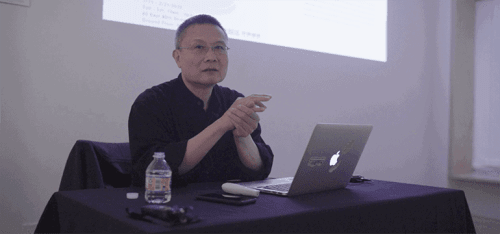“LINE IS LIKE A VIDEOTAPE, AND AUDIENCES ARE LIKE MACHINES. THEY DECIPHER THE MOVEMENT AND THE SPACE INSIDE THE LINE, FROM THE FIRST STROKE OF THE FIRST CHARACTER TO THE LAST STROKE OF THE LAST CHARACTER.”
The reconceptualization of calligraphy constitutes an indispensable aspect of Fung Ming Chip’s calligraphic practice. The talk “Calligraphy Lab Report” introduces ideas critical to the artist’s work, including tradition, line, space, time, conceptual framework, and painting. By elaborating on these ideas, Fung shares insights into his theoretical approach and working procedures. This talk was held in conjunction with Fung Ming Chip’s solo exhibition The Null Set at Fu Qiumeng Fine Art.In this lecture, Fung Ming Chip classified his calligraphic works into six categories:
1. Traditional Calligraphy
2. Line: refers to scripts that shift the tempo and structure of writing and that deviate from established standards people use to judge lines and visual effects. Examples include music script and loose script.
3. Space: The handling of the brush is critical to traditional calligraphy. When looking at a calligraphic piece, viewers visualize how the brush moves in space, regardless of the kind of paper the artist uses. In this case, whether the lines are close or faraway, whether the space is shallow or deep, and whether the work is written on paper, wood, or a wall hardly matter. They are merely the material support. The second category “space” refers to works that transform and integrate these material supports into the calligraphic space. Examples include transparent script and Radical Script, Landscape.
 |
 |
|
|
“Line" |
"Space" |
|
4. Time: refers to the order in which ink and brush leave traces on paper. These scripts underline the passing of time and process. Examples include time script and reverse time script.
5. Concept: Refers to artworks with conceptual framings. Examples include black on black script, border script, and sequence mounting script.
6.Painting-Calligraphy: refers to works that combine painting and calligraphy. Examples include Sand Script, Airplane and Form Sand Script, Transparent Script.
 |
 |
| “Time” |
“Painting-Calligraphy”
|


